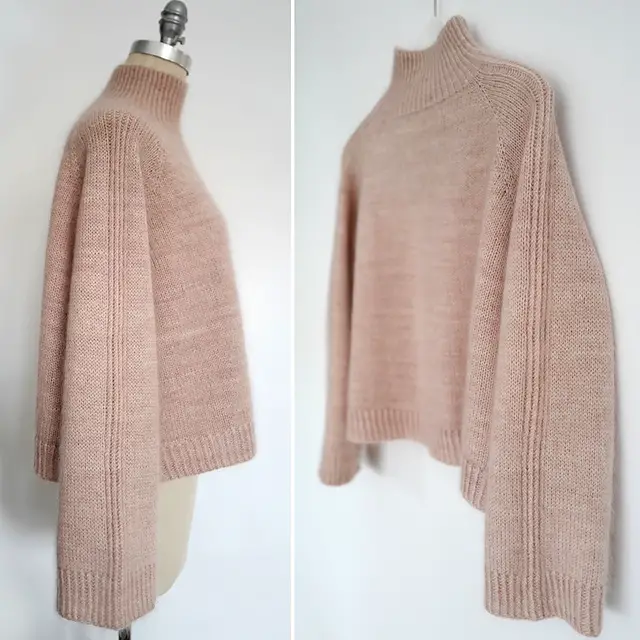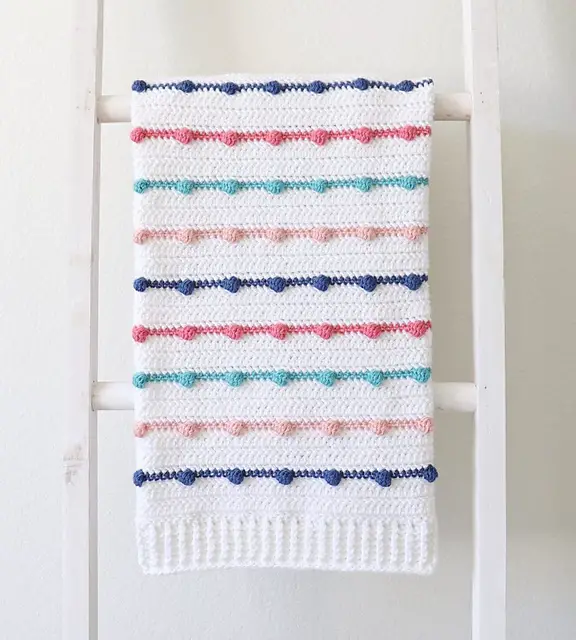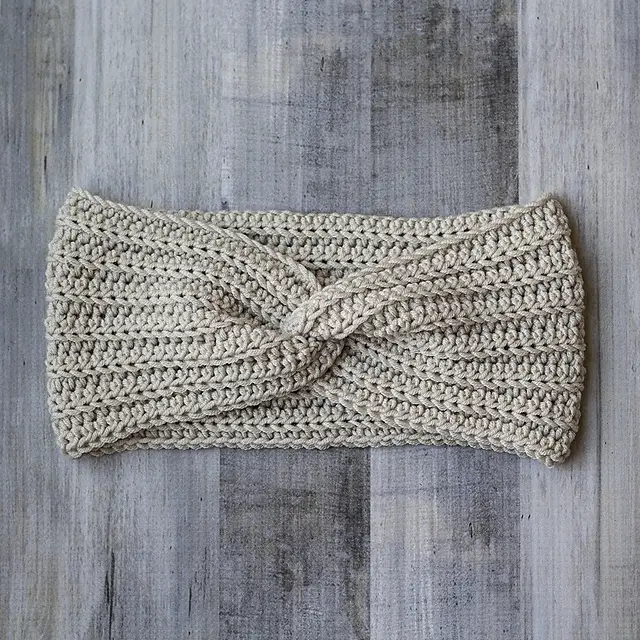When I learned to crochet over 10 years ago, yarn weights were not on my radar. I sort of knew what they were by looking, but didn’t take the time to learn the different types. When I came across a pattern that listed DK yarn, I was like, what is that? None of the yarn labels said “DK”!
Light weight yarn is more commonly known as DK weight. It is a middle weight yarn, slightly thicker than Fine/Sport weight yarn, but not quite as thick as worsted weight. Compared to the lighter weight yarns, DK is easy to handle, fast to work with, and great for nearly any project.
In the beginning, yarn weights confused me because many terms are used interchangeably for the same yarn, but I didn’t know their meanings. I know I’m not the only one out there that struggled with this. But yarn weights are so important because they affect the look of your project.
Take a look at the projects above. They would not have that look if DK weight yarn were not used. If you want to snag the free patterns, click the links (left to right): Paloma by Espace Tricot, Bobble Lines Baby Blanket by Daisy Farms Craft, and Simple Twisted Earwarmer by Rebecca Langford.
I have already covered Lace Weight, Super Fine Weight, and Fine Weight in previous articles. So if you have questions about those, I encourage you to give ’em a read.
This article in particular will answer those burning questions you might have regarding DK weight yarn. Without further ado, let’s get into it!
DK Weight Yarn Standards
The Craft Yarn Council (CYC) created a standard yarn weight system for the US. It is based on a number system that starts from 0, the thinnest, and goes up to 7, the thickest. Light weight yarn is what the CYC considers a 3. Besides the numbering system, the CYC also gives guidelines for gauge and hook/needle sizes for light weight yarn.
Gauge and Tool Recommendations
Gauge, hook and needle suggestions for knit and crochet are printed on the labels. These are based on the testing done by the yarn manufacturers.
But the CYC put a set of guidelines for everyone (in the US) to use, which is listed below. The information is based off of the CYC website and you can access that here for more details.
| | Standard CYC Gauge* | CYC Recommended Tool Size |
| Knit | 21 – 24 sts stockinette | 3.75 – 4.5mm, 5 – 7(US) needles |
| Crochet | 12 – 17 sts sc | 4.5 – 5.5mm, 7 – I-9(US) hook |
Ravelry (an online database for crochet and knitting patterns) also provides a guideline for knit gauge. According to them, you should get 22 stitches per 4 inches (10 cm). You can see that this is in align with what the CYC says.
Remember though, these are not exact. The gauge and hook/needle size provide you with a strong baseline, but you should always do your own testing.
Wraps Per Inch
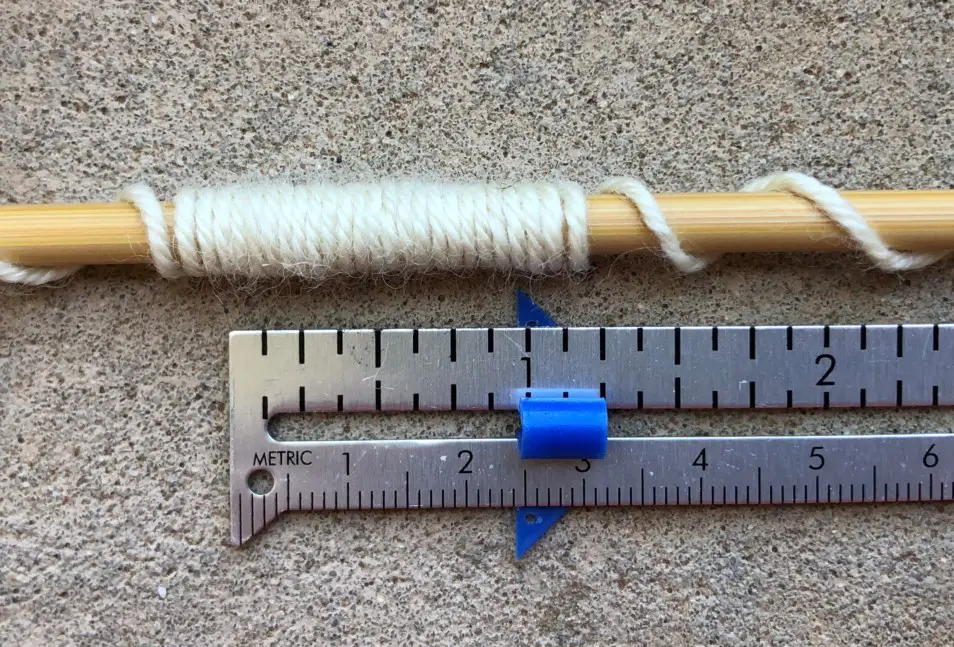
Wraps per inch (WPI) is useful for yarn weights if you ever lose your labels. Measuring WPI is super simple. The CYC has more detailed information on their website here. But basically you wrap yarn around a pencil. Then you measure an inch and count how many wraps are in that inch. Finally, you compare to the CYC standards for WPI to know what the yarn weight is.
The CYC states that light weight (3) should have 11-15 wraps per inch. Bluprint says that DK weight yarn is 12-14 WPI, which is a smaller margin, but still in alignment with the CYC. You can access the Bluprint article here. Ravelry states that DK weight yarn should be 11 WPI according to their yarn weight standards page.
As for me, what is pictured is Dyer Supplier BFL DK yarn and I got 19 wraps per inch. I may have tugged on the yarn too tightly for the photo, so I went back and remeasured. I got 17 wraps per inch.
I don’t have any other DK weight yarn to compare these numbers to, but I thought I would mention it just in case you run into this problem too. It’s a good lesson to always check gauge before starting any project.
Other Common Terms for Light Weight Yarn
As I mentioned previously, the CYC created the yarn weight system for the US. Fine weight is equivalent to a 3 according to their standards. But not everyone in the world uses the same terminology. I summarized the most common terms used for lace weight yarn below, and I will go into more detail about each.
Also Known As
- Light – 3
- DK
- Light Worsted
- 8-ply
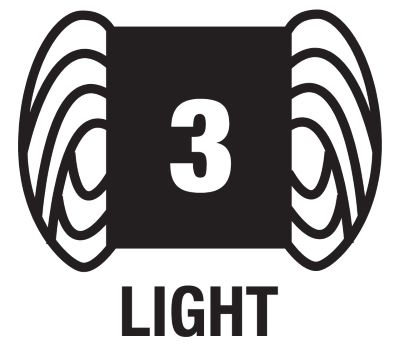
In the US, and other countries, fine weight yarn is also commonly called DK and light worsted yarn. Often, these terms are used interchangeably.
- Light – 3. This is how the Craft Yarn Council refers to the middle weight yarn. The symbol above is what is printed on yarn labels in the US so that you can easily identify the yarn weight.
- DK yarn. DK stands for “double knit” and it is a term often used in the US and UK. There are couple of theories floating around about the origins of the term. It doesn’t matter which origin story you believe, I just think they are interesting. What does matter is that you know what yarn DK refers to.
- In the UK, yarn used to be spun into a uniform thickness. If you wanted something thicker, generally you would use multiple strands of the same knitting yarn. So two strands would be used for a fabric twice as thick, thus the term “double knitting.”
- Another theory I’ve seen has roots in Great Britain in the post-WWII era. Materials and labor were short. So in an attempt to conserve materials, a single yarn was spun to fit between Sport and Worsted weight. The needle size could go up or down to achieve a smaller or bigger gauge for DK yarn. You could say DK “doubles” for both yarn weights.
- Light Worsted yarn. This is usually a term used in the US to mean light weight yarn. The next thickest weight yarn is called “worsted” weight. Light worsted implies it is smaller than worsted.
The UK, Australia and New Zealand tend to refer to yarn weights by plies. The lower the ply count, the thinner the yarn. Although, don’t confuse this with how many plies the yarn is actually composed of. Ply count used to refer to the number of strands in the yarn, but modern processes have changed that. Now the term ply simply means the thickness of the yarn, when referring to yarn weights.
I looked at several sources to hopefully give the most accurate information, as I live in the US and don’t use this notation for yarn weights. This is what I found.
- 8-ply. In multiple sources that I found, 8-ply is generally a term used in Australia and New Zealand. Whereas, Ravelry adds the UK into the mix. Either way, 8-ply just means light or DK weight yarn.
Important Properties of Light Weight Yarn
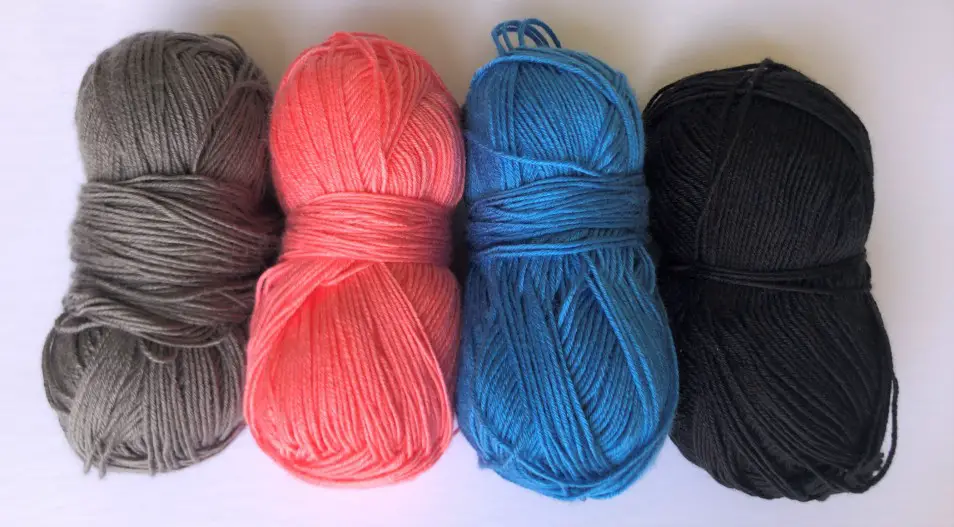
Light weight yarn has several important properties that affect every purchaser of yarn. First there is fiber content. It is important to know what fibers the yarn is made from so you know how to treat it for your projects. Next, the yardage is important because that affects the project size. Finally, the price of the yarn is an important property that affects whether or nor you buy it.
Throughout these next sections, I dive deeper into each property of light weight yarn. In order to do so, I conducted my own research. I looked at five major yarn companies so I could understand more about industry behaviors regarding yarn weights. I hope you find it interesting!
Common Fiber Content
I like to break fiber content into three categories: natural fibers, synthetic fibers, and blends of natural and synthetic fibers. According to my research, 16% of light weight yarn is made from natural fibers and 63% is made from synthetic fibers. The other 22% is a blend of natural and synthetic fibers.
This makes sense because DK weight is a very versatile yarn. More synthetic fibers are available so that projects are easier to wash. You will find that many yarns in this weight category are 100% acrylic.
I have summarized the common fibers below, but I did not add the blends because those can vary.
Natural Fibers
- Cotton
- Wool
- Merino
- Superwash Merino
- Mohair
- Silk
- Cashmere
- Alpaca
- Linen
Synthetic Fibers
- Acrylic
- Nylon
- Rayon
- Polyester
- Viscose
- Tencel
- Lurex
Yardage Estimation
When it comes to yardage, unfortunately there is no set standard for the amount of yards per ounce/gram. That is up to the yarn manufacturer. But I was curious, just as I am sure you are, how many yards I can expect on average for light weight yarn. This is super important when planning for a pattern.
As I stated before, I looked at 5 major yarn companies in the US. The following is based on my findings. For light weight yarn, you can expect 377 yards per skein on average. The lowest amount of yardage I came across was 123 yards and the highest was 1263 yards.
Average Price
Price is also an important aspect to keep in mind when you are choosing and comparing yarn. I found that you can expect to pay on average $6.95 per skein of light weight yarn. Of course, that also means you could pay much more or much less depending on where you shop.
Where to Find Light Weight Yarn
Light weight yarn can be found in many places. Most chain craft stores have a small variety of light/DK weight yarn in stores. Baby yarn is where I most commonly see DK weight, at least in the craft stores in my area.
If you have a locally owned yarn shop in your area, you would have a much bigger selection of DK weight yarn to choose from. I, however, don’t have that luxury, but wish I did.
Finally, you can always buy light weight yarn online. There are many yarn retailers that have DK weight yarns for sale. The only drawbacks are that you must wait for its arrival (so hard!) and you can’t feel the yarn before purchasing.
Types of Projects Best for Light Weight Yarn
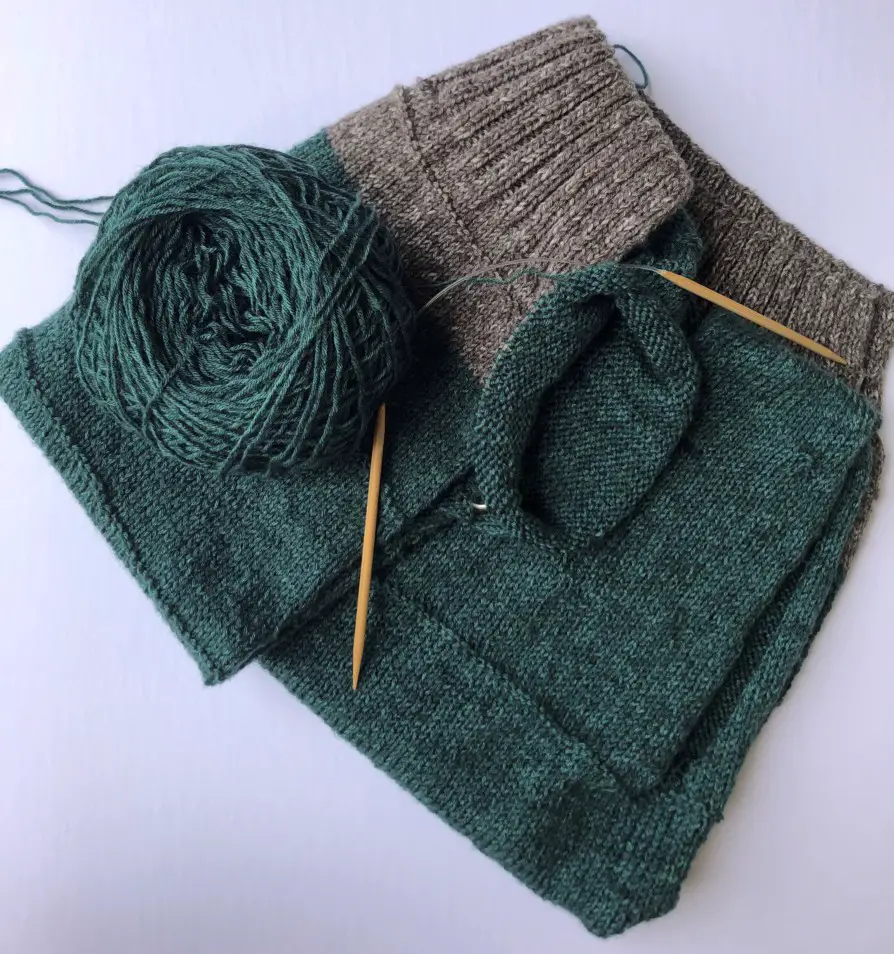
Light weight yarn produces a sturdy fabric that holds its shape better than its thinner yarn weight counterparts. Yet, the fabric remains lightweight. Depending on the stitch pattern used and the hook or needle size, there can be a lot of drape to the fabric as well.
DK is much easier to knit or crochet than lace, fine or super fine weight. Projects will also work up much faster, but can get tedious because its thickness is still fairly small.
Ravelry has a total of 151,998 patterns (at the time of this post) that uses DK weight yarn. And over 52,500 of those patterns are free! You will no doubt find a project that you like.
Popular items to knit or crochet with light weight yarn include cardigans, hats, accessories, and baby items. The fabric is lightweight for clothing and accessories, but can be also heavy enough for the cooler months.
I compiled a list of all the project types I could think of that pair well with light weight yarn. You are by no means limited to only these projects, but I hope they spark some inspiration!
Garments
- Tops
- Dresses
- Socks
- Sweaters
- Shawls
- Jackets
- Baby clothes
- Ponchos
Accessories
- Cowls
- Scarves
- Bags
- Gloves
- Hats
- Earwarmers
- Baby Booties
Home
- Blankets/Afghans
- Amigurumi Stuffed Animals
- Decorations
- Face Cloths
- Wall Hangings
Light Weight Yarn Recommendations + Tips
DK weight yarn is a popular yarn weight because of its versatility. Recently, I have been using it on a project for a stuffed animal and a sweater. I love the tight stitches that I get.
I’ve been using Lion Brand Touch of Merino, which is fabulous! It is 10% Merino Wool and 90% Acrylic and it is super soft. I also like the Bernat Softee Baby yarn (it is so soft!) in white because it pairs with many things. And the sweater pictured in the section above is made from Yarn Bee Soft & Sleek DK.
Tips:
- Try holding two strands of lace weight together. This will result in a Sport weight to DK weight yarn. If you get sport weight, try the next suggestion.
- Try holding two strands of fingering weight together. You will either get a DK weight or Worsted weight yarn as a result. If you don’t get the size of light weight yarn as a result, try my last suggestion.
- Try holding a strand of lace weight and a strand of fingering weight together. If you follow the above suggestions, you may find that you get a result that is in between yarn weights, but never DK. So try holding a strand of lace with a strand of fingering weight. You may just find a sweet spot that creates the light weight yarn you need.
Up Next
That concludes Light Weight yarn (3). The next post covers Worsted Weight yarn (4), which is the next size up. You can find it here.
The pictures listed at the top of the post are available in pattern form free through Ravelry. I do not claim these photos as my own, they are merely for illustration purposes. Click the links here to learn more about the patterns: Espace Tricot, Daisy Farm Crafts, Rebecca Langford

